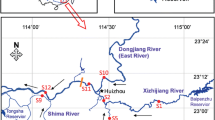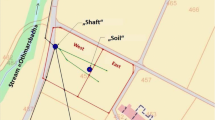Abstract
From 2010 to 2012, the Yangtze River and Hanjiang River (Wuhan section) were monitored for estrogenic activities during various water level periods. Using a recombinant yeast estrogen screen (YES) assay, 54 water samples were evaluated over the course of nine sampling campaigns. The mean 17β-estradiol equivalent (EEQ) value of raw water from the Yangtze River was 0–5.20 ng/L; and the EEQ level from the Hanjiang River was 0–3.22 ng/L. In Wuhan, drinking water treatment plants (DWTPs) using conventional treatments reduced estrogenic activities by more than 89 %. In general, water samples collected during the level period showed weaker estrogenic activities compared to those collected during the dry period. The samples collected in 2010 showed the strongest estrogenic activities of the 3-year period. The lack of correlations between estrogenic activities and selected common water quality parameters showed that estrogenic activity cannot be tied to common water quality parameters.





Similar content being viewed by others
References
Alvarez DA, Shappell NW, Billey LO, Bermudez DS, Wilson VS, Kolpin DW, Perkins SD, Evans N, Foreman WT, Gray JL, Shipitalo MJ, Meyer MT (2013) Bioassay of estrogenicity and chemical analyses of estrogens in streams across the United States associated with livestock operations. Water Res 47:3347–3363
Beek IC, Bruhn R, Gandrass J (2006) Analysis of estrogenic activity in coastal surface waters of the Baltic Sea using the yeast estrogen screen. Chemosphere 63:1870–1878
Céspedes R, Lacorte S, Raldúa D, Ginebreda A, Barceló D, Piña B (2005) Distribution of endocrine disruptors in the Llobregat River basin (Catalonia, NE Spain). Chemosphere 61:1710–1719
Chen C, Wen T, Wang G, Cheng H, Lin Y, Lien G (2007) Determining estrogenic steroids in Taipei waters and removal in drinking water treatment using high-flow solid-phase extraction and liquid chromatography/tandem mass spectrometry. Sci Total Environ 378:352–365
Department of environmental protection of Hubei Province (2013) Annual report on environmental quality. http://www.hbepb.gov.cn/hbyw/. Accessed 5 Nov 2014
Desbrow C, Routledge EJ, Brighty GC, Sumpter JP, Waldock M (1998) Identification of estrogenic chemicals in STW effluent. 1. Chemical fractionation and in vitro biological screening. Environ Sci Technol 32:1549–1558
Eertmans F, Dhooge W, Stuyvaert S, Comhaire F (2003) Endocrine disruptors: effects on male fertility and screening tools for their assessment. Toxicol In Vitro 17:515–524
Fernandez MP, Buchanan ID, Ikonomou MG (2008) Seasonal variability of the reduction in estrogenic activity at a municipal WWTP. Water Res 42:3075–3081
Grover DP, Zhou JL, Frickers PE, Readman JW (2011) Improved removal of estrogenic and pharmaceutical compounds in sewage effluent by full scale granular activated carbon: impact on receiving river water. J Hazard Mater 185:1005–1011
Hakk H, Sikora L, Casey FXM, Larsen GL (2014) Fate of 17 beta-estradiol in anaerobic lagoon digesters. J Environ Qual 43:701–708
Hansen PD, Dizer H, Hock B, Marx A, Sherry J, McMaster M, Blaise C (1998) Vitellogenin—a biomarker for endocrine disruptors. TrAC Trend Anal Chem 17:448–451
Hu X, Shi W, Cao F, Hu G, Hao Y, Wei S, Wang X, Yu H (2013) Bioanalytical and instrumental analysis of estrogenic activities in drinking water sources from Yangtze River Delta. Chemosphere 90:2123–2128
Iparraguirre A, Navarro P, Rodil R, Prieto A, Olivares M, Etxebarria N, Zuloaga O (2014) Matrix effect during the membrane-assisted solvent extraction coupled to liquid chromatography tandem mass spectrometry for the determination of a variety of endocrine disrupting compounds in wastewater. J Chromatogr A 1356:163–170
Jin T, Lv X, Zeng Y, Zhang B, Ma K, Jiang P, Tang F (2013) Comparison of the estrogenic activity of organic compounds in source water and finished water from the Yangtze River and Taihu Lake in certain areas of Jiangsu Province. Environ Sci 34:1351–1356 (in Chinese)
Jobling S, Nolan M, Tyler CR, Brighty G, Sumpter JP (1998) Widespread sexual disruption in wild fish. Environ Sci Technol 32:2498–2506
Jugan ML, Oziol L, Bimbot M, Huteau V, Tamisier-Karolak S, Blondeau JP, Levi Y (2009) In vitro assessment of thyroid and estrogenic endocrine disruptors in wastewater treatment plants, rivers and drinking water supplies in the greater Paris area (France). Sci Total Environ 407:3579–3587
Lee BC, Kamata M, Akatsuka Y, Takeda M, Ohno K, Kamei T, Magara Y (2004) Effects of chlorine on the decrease of estrogenic chemicals. Water Res 38:733–739
Liscio C, Magi E, Di Carro M, Suter MJF, Vermeirssen ELM (2009) Combining passive samplers and biomonitors to evaluate endocrine disrupting compounds in a wastewater treatment plant by LC/MS/MS and bioassay analyses. Environ Pollut 157:2716–2721
Lloret L, Eibes G, Teresa Moreira M, Feijoo G, Lema JM (2013) Removal of estrogenic compounds from filtered secondary wastewater effluent in a continuous enzymatic membrane reactor. Identification of biotransformation products. Environ Sci Technol 47:4536–4543
Maggioni S, Balaguer P, Chiozzotto C, Benfenati E (2013) Screening of endocrine-disrupting phenols, herbicides, steroid estrogens, and estrogenicity in drinking water from the waterworks of 35 Italian cities and from PET-bottled mineral water. Environ Sci Pollut Res 20:1649–1660
Oh SM, Kim HR, Park HK, Choi K, Ryu J, Shin HS, Park J, Lee JS, Chung KH (2009) Identification of estrogen-like effects and biologically active compounds in river water using bioassays and chemical analysis. Sci Total Environ 407:5787–5794
Pelissero C, Flouriot G, Foucher JL, Bennetau B, Dunogues J, Le Gac F, Sumpter JP (1993) Vitellogenin synthesis in cultured hepatocytes; an in vitro test for the estrogenic potency of chemicals. J Steroid Biochem Mol Biol 44:263–272
Petrovic M, Barcelo D (2007) Analysis of steroid estrogens in the environment. Blackwell, London
Rastall AC, Neziri A, Vukovic Z, Jung C, Mijovic S, Hollert H, Nikcevic S, Erdinger L (2004) The identification of readily bioavailable pollutants in Lake Shkodra/Skadar using semipermeable membrane devices (SPMDs), bioassays and chemical analysis. Environ Sci Pollut Res 11:240–253
Rice EW, Baird R, Eaton AD, Clesceri LS (2005) Standard methods for the examination of water and wastewater, 21st edn. American Public Health Association
Rodriguez-Mozaz S, de Alda M, Barcelo D (2004) Monitoring of estrogens, pesticides and bisphenol A in natural waters and drinking water treatment plants by solid-phase extraction-liquid chromatography-mass spectrometry. J Chromatogr A 1045:85–92
Routledge EJ, Sumpter JP (1996) Estrogenic activity of surfactants and some of their degradation products assessed using a recombinant yeast screen. Environ Toxicol Chem 15:241–248
Safe S (2004) Endocrine disruptors and human health: is there a problem. Toxicology 205:3–10
Saravanabhavan G, Helleur R, Hellou J (2009) GC-MS/MS measurement of natural and synthetic estrogens in receiving waters and mussels close to a raw sewage ocean outfall. Chemosphere 76:1156–1162
Schwarzenbach RP, Escher BI, Fenner K, Hofstetter TB, Johnson CA, von Gunten U, Wehrli B (2006) The challenge of micropollutants in aquatic systems. Science 313:1072–1077
Shao X, Wen G, Ma J (2009) Survey of estrogenic activity of Songhua River water and drinking water of Harbin. Environ Sci 30:1362–1367 (in Chinese)
State Bureau of Standards (2007) Standards for drinking water quality in National Standard of the People’s Republic of China, vol. GB 5749-2006
Vanparys C, Depiereux S, Nadzialek S, Robbens J, Blust R, Kestemont P, De Coen W (2010) Performance of the flow cytometric E-screen assay in screening estrogenicity of pure compounds and environmental samples. Sci Total Environ 408:4451–4460
Zeng Q, Cao W, Xu L, Chen Y, Yun L, Liu A, Zhang J, Lu W (2013) Spatial and temporal evaluations of estrogenic activity in tap water served by a water plant in Wuhan, China. Ecotoxicol Environ Saf 91:198–203
Zhang L, Wang X, Ya M, Wu Y, Li Y, Zhang Z (2014) Levels of endocrine disrupting compounds in South China Sea. Mar Pollut Bull 85:628–633
Acknowledgments
We thank Wuhan Water Group Company for their assistance in the experimental work. Financial support from the City Construction Committee of Wuhan, Research Project No. 200734, is gratefully acknowledged. This paper has been carefully checked for English by Andrew Chatwood, an outstanding Canadian technical writer. We appreciate his professionalism and kindness very much.
Author information
Authors and Affiliations
Corresponding author
Ethics declarations
Conflict of interest
The authors declare that they have no conflict of interest.
Ethics statement
The work described has not been published before and is not under consideration for publication anywhere else. Its publication has been approved by all coauthors.
Additional information
Responsible editor: Philippe Garrigues
Highlights
• This is the first study to systematically assess drinking water samples from both the Yangtze River and the Hanjiang River for estrogenic activity.
• The water samples were collected from the two rivers over a 3-year period, during diverse water level seasons, and assessed for estrogenic activities.
• Conventional drinking water treatment plants effectively reduced estrogenic activity.
• There were no correlations between estrogenic activities and common water quality parameters.
Electronic supplementary material
Below is the link to the electronic supplementary material.
ESM 1
(PDF 244 kb)
Rights and permissions
About this article
Cite this article
Xiao, S., Lv, X., Lu, Y. et al. Occurrence and change of estrogenic activity in the process of drinking water treatment and distribution. Environ Sci Pollut Res 23, 16977–16986 (2016). https://doi.org/10.1007/s11356-016-6866-z
Received:
Accepted:
Published:
Issue Date:
DOI: https://doi.org/10.1007/s11356-016-6866-z




